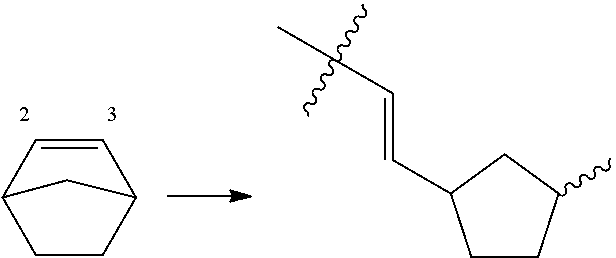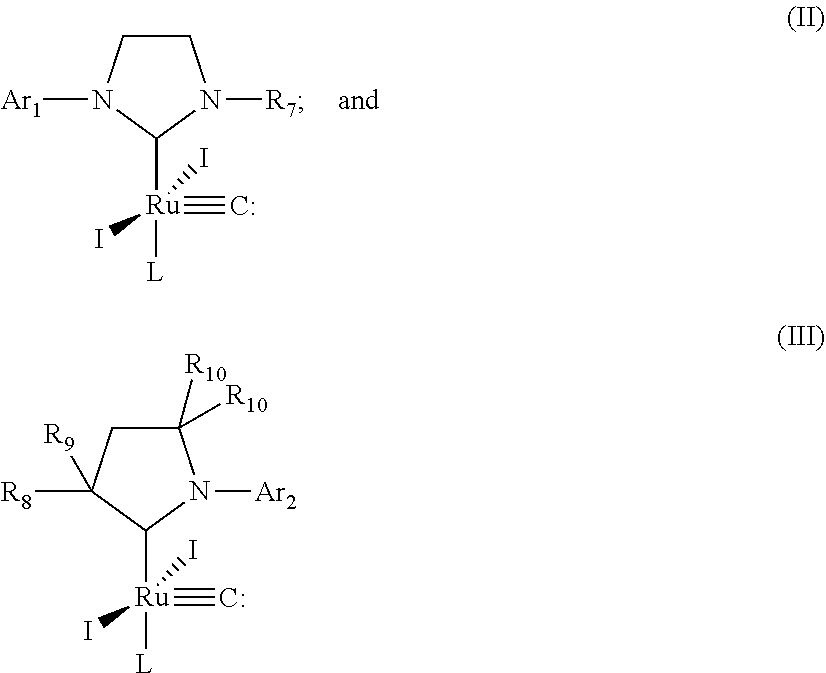Single component mass polymerizable compositions containing polycycloolefin monomers and organoruthenium carbide precatalyst
a technology of polycycloolefin monomer and monomer, which is applied in the direction of coatings, etc., can solve the problems of not being suitable for 3d ink, achieve high heat distortion temperature, improve thermal and mechanical properties, and avoid oxidation
- Summary
- Abstract
- Description
- Claims
- Application Information
AI Technical Summary
Benefits of technology
Problems solved by technology
Method used
Image
Examples
example 1
Mass Polymerization of PENB
[0169]In a glass bottle, Ru-4 (1 molar part) and CPTX (2 molar part) were dissolved in PENB (10,000 molar parts) without solvent to form a clear solution. In a separate glass bottle, Rhodorsil 2074 (2 molar parts) was dissolved in sufficient toluene (about 1 weight percent of total formulation). Both solutions were mixed together and purged with nitrogen for 2 hours. The solution was UV light exposed (UV LED flash light 395 nm for 3 min). The solution turned to a solid indicating the monomer was fully polymerized, as confirmed by both UV / DSC and TGA. The heat of reaction as measured by UV / DSC was 180 J / g. The residue percentage from isothermal TGA (1 h at 100° C.) after UV exposure was >99%.
examples 2-4
Mass Polymerization of Various Monomers
[0170]The procedures of Example 1 were substantially repeated in these Examples 2 to 4 except that various different monomers and catalyst as listed in Table 1 were employed. NBEtO-2-PhPh itself served as a solvent to dissolve Rhodorsil 2074 in these Examples 2-4, instead of toluene. The monomers used in each of these Examples 2 to 4, catalyst loading, Rhodorsil 2074 and heat of reaction from UV DSC are summarized in Table 1.
TABLE 1ExampleMonomersRu-complex loading,UV DSC,No.(molar parts)(molar parts)J / g2PENB / NBEtO-2-PhPhRu-227090 / 10 molar ratio (10,000)(1)3PENB / NBEtO-2-PhPhRu-417090 / 10 molar ratio (10,000)(1)4DCPD / PENB / NBEtO-2-PhPhRu-4 5085 / 5 / 10 molar ratio(1)(10,000)
examples 5-7
Shelf Life Studies
[0171]In a glass bottle, Ru-catalysts (1 molar part) and CPTX (2 molar parts) were dissolved in PENB (9,000 molar parts) to form a clear solution. In a separate glass bottle, Rhodorsil 2074 (2 molar parts) was dissolved in NBEtO-2-PhPh (1,000 molar parts). Both solutions were mixed together and purged with nitrogen for 2 hours. Viscosity changes at room temperature was monitored and are summarized in Table 2. As summarized in Table 2, all of the compositions were in liquid form with more or less same or similar viscosities even at the end of seven days.
TABLE 2Viscosity atday 7,ExampleRu-visualNo.complexobservation5Ru-2liquid6Ru-4liquid7Ru-7liquid
PUM
| Property | Measurement | Unit |
|---|---|---|
| Temperature | aaaaa | aaaaa |
| Length | aaaaa | aaaaa |
| Viscosity | aaaaa | aaaaa |
Abstract
Description
Claims
Application Information
 Login to View More
Login to View More - R&D
- Intellectual Property
- Life Sciences
- Materials
- Tech Scout
- Unparalleled Data Quality
- Higher Quality Content
- 60% Fewer Hallucinations
Browse by: Latest US Patents, China's latest patents, Technical Efficacy Thesaurus, Application Domain, Technology Topic, Popular Technical Reports.
© 2025 PatSnap. All rights reserved.Legal|Privacy policy|Modern Slavery Act Transparency Statement|Sitemap|About US| Contact US: help@patsnap.com



